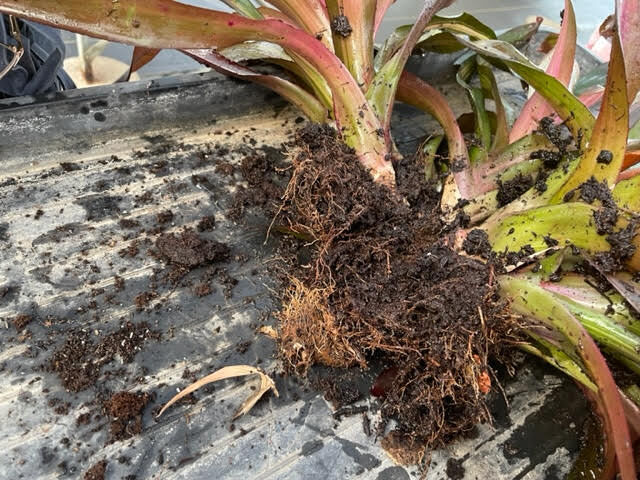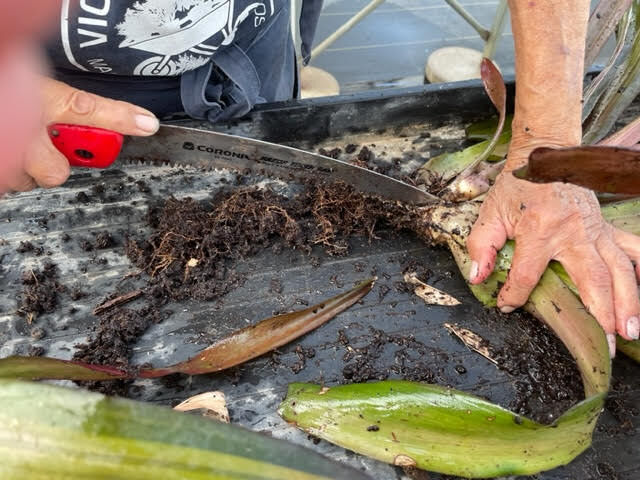The fantastical, flamboyant bromeliad
Gardeners’ Dirt by Sandra Heinold and Lupe Cook/Victoria County Master Gardeners
August 5, 2023

Step 1: Take plant out of pot and wash the soil off the roots. Now it will be easy to see where the pups are attached to the mother plant.

Step 2: Separate the pup from its mother by making a clean cut between the pup’s base and the mother’s base. Continue around the plant until all the pups are off. Try to get some roots with each pup, but they will usually grow even without roots.

Step 3: Plant the pups into new pots, making sure to plant them no deeper that they were in the original soil. It may be necessary to put stakes around them to stabilize them until their roots anchor in. Repot the mother plant into a new pot with new soil.

Step 4: Fill their tanks with water and water the soil if it is not moist. Make sure the soil does not remain saturated.
All photos by Sandra Heinold/Victoria County Master Gardener
I have always found bromeliads to be exotic and mysterious, full of personality. They’re a group of plants that I find attractive but don’t always know how to manage.
Usually found in the houseplants section of the nursery, their architectural forms, patterned leaves, and bright fantastical blooms beckon me to look and buy. And I did. Thankfully, they are tough plants and can survive a great deal of well-intentioned ignorance and benign neglect. And they are nontoxic.
Against all odds my bromeliads grew and thrived to the point where I had to divide them. So, I called on my fellow master gardener Lupe Cook to teach me how to divide and grow them into new plants. Since then, I have done the research I should have done when I bought them and discovered how really fascinating bromeliads are.
Bromeliads are tropical, epiphytic plants, which just means that they like it warm and moist and have aerial roots. Their natural habitat is in the bright, humid shade under tall trees where they attach themselves to lower branches or find a home in the dappled shadows on the forest floor.
Their roots are used mainly to attach themselves to structures and to provide stability rather than to take up water and food. Instead, they have tiny, specialized scales on their leaves that allow them to absorb moisture and nutrients directly from the air. These facts give us clues about how to grow them.
The bromeliads most often available for use in the home are of the tank or vase kind, which means that their leaves grow in a rosette around a central space, creating a well or tank for collecting water. And that is how we should water them, by filling up the tank. The water will trickle down to the base of the plant and eventually into the soil.
A balanced houseplant fertilizer diluted one-fourth to one-half strength can be added to the water frequently during the summer months only. The actual soil in the pot is there mostly to anchor the plant, so it’s not necessary to water it, though it shouldn’t be bone dry for long periods. Slightly moist soil is best.
If you have a moisture meter, a level between 2 and 4 is ideal, but too little is better than too much. Bromeliads are sensitive to metals so you shouldn’t use a metal watering can.
In general, bright, indirect light is best for most bromeliads, especially if your plant has stiff, hard leaves. If its leaves are soft, more flexible, it may require a darker area. Most bromeliads won’t tolerate direct sunlight which can damage their foliage.
Bromeliads flourish in temperatures between 50 and 90 degrees, but most commonly grown ones will tolerate a wider temperature range. They enjoy humidity levels between 50 and 75%, but may require higher humidity at higher temperatures. Please note, bromeliads will not survive freezing temperatures.
Our climate in the summer is very like bromeliads’ natural habitat, which means they can vacation here in their pots outdoors, in the shade of trees or on a shaded porch, during the warmer months.
To create an exotic, colorful display in shady beds, you can arrange several bromeliads at different levels among the trees and ferns in your shaded beds. Using different varieties will make the site especially attractive.
Given appropriate growing conditions, your bromeliad very likely will respond by blooming and developing side shoots called pups. Sometimes bromeliads have pups without blooming. You can separate pups from the mother plant and grow new plants. This type of propagation allows you to increase your collection of these flamboyant, fantastical plants.
References
aggiehorticulture.edu
thespruce.com
hort.extension.wisc.edu
The Gardeners’ Dirt is written by members of the Victoria County Master Gardener Association, an educational outreach of Texas A&M AgriLife Extension – Victoria County. Mail your questions in care of the Advocate, P.O. Box 1518, Victoria, TX 77901; or [email protected], or comment on this column at VictoriaAdvocate.com.